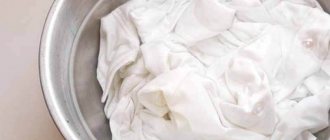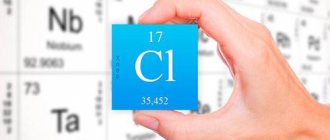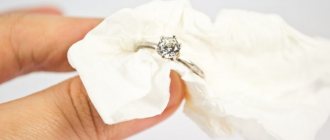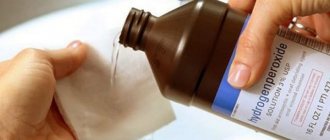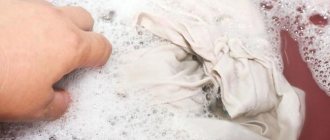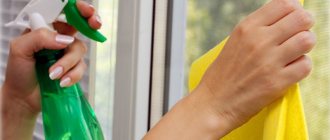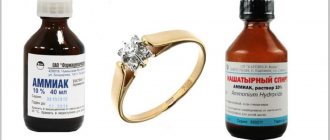No matter how carefully you treat white things, the influence of various factors can lead to the appearance of stains, yellowness and grayness. Regular washing of clothes cannot be done here; you need to resort to bleaching them.
As a bleach, you can use special household detergents or proven folk remedies.
Oxygen-containing
This is a new generation of bleaches.
They are able to delicately restore whiteness even without boiling, and are suitable for fabrics of any composition. There are two types of bleaches containing oxygen: in bulk form or in solution form. Their gentle formula allows you to use bleaches as an additive when washing in machines, without requiring pre-soaking. Linen that has turned yellow will become white, and colored items will restore their shade. The cost of bleaching products containing oxygen is significantly higher than chlorine-containing ones.
Correspondence of bleaches to fabric types
Each type of fabric has its own method. Here's a quick match:
- “Whiteness” and other chlorine-containing bleaches – cotton, linen;
- oxygen bleaches - all types of fabric in accordance with the instructions;
- optical brighteners - all types of fabric according to instructions;
- peroxide with ammonia - all fabrics;
- soda - cotton, linen;
- laundry soap - cotton;
- mustard - all fabrics;
- salt – synthetic and linen fabrics.
Please remember that not every item can be returned to its original condition. Clothes that are too old will never become new, no matter how hard you try.
When bleaching white clothes, don't take risks. Try a new product on a small unnecessary piece or an inconspicuous edge of the product. Don't use bleach too often. Constant exposure thins the fibers of the material, and the item may deteriorate.
Store products
If you don’t trust folk remedies, using laundry bleach at home will easily remove stains and make your clothes white. You can whiten white items with bleach or bleach.
Add powder and a little bleach to the washing machine, load a white T-shirt and other clothes, select the delicate cycle. After washing, hang things out in the fresh air.
You can bleach things at home using the following bleaches:
- oxygen stain remover Astonish Oxy-Plus Stain Remover;
- Dual Power Pre-Treatment stain remover;
- Vanish Oxi Action stain remover for white clothes;
- stain remover salt Dr. Beckmann.
How to wash white clothes.
If you want your fabrics to always be snow-white, you need to know a few simple rules to ensure that your laundry remains light for the longest possible time without the use of heavy chemicals:
- You cannot wash white items together with items of a different color. They can mix, and it will be almost impossible to return the original shade.
- When cleaning, be sure to consider the material the garment is made from. It is necessary to separate linens made from wool and silk, as they need different water temperatures in order to comfortably handle the wash.
- If your outfit has a lot of stains, soak it first and then clean it.
- White things love the sun, so it is better to dry them under its rays.
- To ensure long laundry life, add a little bleach in liquid or powder form to the drum.
Ammonia
Using ammonia, you can bleach natural fabrics that have yellow or gray stains on them.
Please note: this method is not suitable for mixed or synthetic materials.
For five liters of water you need to take one tablespoon of ammonia. First, you need to treat the areas of greatest contamination, then soak the entire product in the solution for several hours. It is important to ensure that the item is completely immersed in water.
Another solution for delicate fabrics
Silk and wool are perfectly bleached using mustard powder. To do this, you need to prepare a solution of 2 liters of hot water and 2 tbsp. mustard powder. This solution needs to be left for two hours, then the water is drained (strained) and the infused mustard is poured again with 2 liters of water. Drain the water again, and mix the mustard mixture infused in this way with the clothes for half an hour, then wash them by hand or in a machine. The use of mustard is also important for whitening kitchen towels.
Whitening clothes at home is the best way
Among the many effective ways to whiten clothes, the best method among housewives is considered to be boiling, with the addition of peroxide and ammonia. For the cleaning process you will need:
- ten-liter saucepan;
- 9 liters of water;
- 50 milliliters of hydrogen peroxide (3%);
- 20 milliliters of ammonia.
Heavily washed and yellowed laundry can be bleached as follows. Place the bedding in boiling water. Boil for 30 minutes. Add half a bottle of three percent peroxide and ammonia directly to the bubbling water. The product must be constantly covered with the solution, so as the water evaporates, you need to add it. After boiling, allow the laundry to cool. Hand wash and rinse. Dry naturally.
Tips and tricks
Not only store-bought products, but time-tested folk recipes help restore the white shine to grayed things. To get the maximum benefit from them, you must follow the tips and recommendations.
How to bleach faded white clothes
White items, when washed at the same time as brightly colored items, lose their snow-white appearance. It is necessary to take action as soon as possible to restore the original whiteness, before the paint eats deep into the fabric.
See also
How to properly wash a cap with a visor so that it does not lose its shape
After unsuccessful washing, you must use the following products:
- linen made from natural fabrics can be washed with laundry soap and chlorine-containing compounds;
- mustard is suitable for silk and wool;
- potassium permanganate is suitable for any things;
- ammonia returns the original color;
- soda along with hydrogen peroxide;
- citric or boric acid.
The items are kept in a solution with a suitable product for 2.5 hours, after which they are rinsed with warm, clean water.
How to restore the snow-white appearance of clothes?
An effective way to restore the whiteness of a T-shirt or jacket is to soak it in water with boric acid or potassium permanganate. The duration of the procedure is on average 2.5 hours.
Boiling and bleaching with Bleach, citric acid or ammonia, hydrogen peroxide, and soda will help make things snow-white.
How to bleach gray, yellowed things?
You can remove grayness, as well as rid your favorite T-shirt or blouse of unpleasant yellowness in the following ways:
- soaking things in a composition based on boric acid, ammonia or hydrogen peroxide helps;
- A mixture of shavings of laundry soap, salt and soda, in which things are left for 10 hours, helps against yellowness.
It is important to choose a product according to the type of material so as not to spoil the clothes.
The collar of a shirt is often a problem area. Regular dish soap, a cotton swab soaked in vinegar, a mixture of table salt and ammonia, lemon juice, talc or hydrogen peroxide will help you deal with yellowness.
How to restore underwear
You can bleach your underwear with affordable products that you can find in your medicine cabinet or kitchen.
Citric acid, baking soda, hydrogen peroxide or regular whiteness will help restore the freshness and newness of your laundry. Vinegar or boric acid can help whiten lace underwear.
What and how to bleach children's clothes
Children's underwear requires special attention. Babies' skin is delicate and sensitive, so you should not use chemicals. It is better to use folk remedies that are characterized by a low level of allergenicity:
- baby soap;
- formulations with hydrogen peroxide;
- soda solution;
- ammonia;
- recipes with citric acid.
A suitable component is diluted in water and the laundry is soaked for 2.5 hours. If you follow all the rules, you will be able to quickly get rid of yellowness and gray tint without harming the child’s health.
Chlorine bleaches
A classic category of products that allows you to bleach even very faded white things at home. They are aggressive both in relation to tissues and in relation to equipment, so they should be used only in the most extreme cases.
We suggest you read: How to remove glue from suede
When using chlorine products, wear household rubber gloves and protect your eyes. Children should not be allowed near the dissolved bleach to avoid inhaling the vapors. After soaking, items should be rinsed very thoroughly to prevent skin irritation.
Potassium permanganate
Potassium permanganate is an excellent bleach, which, however, you need to be extremely careful with. After all, if you overdo it with the concentration of potassium permanganate, then white things can easily turn a creepy crimson color. On the other hand, which is absolutely surprising, potassium permanganate is an indispensable tool for bleaching faded white things.
You need to dilute a small amount of the product in water: the solution should turn out pale pink. Pour the resulting solution into the clothes, keep them in it for half an hour and immediately continue washing with the powder in the machine.
Baking soda
You can deal with things that have lost their whiteness at home without boiling. Soda not only can whiten white linen, but also helps maintain the structure of the fabric unchanged for a long time. For 1 liter of water add 1 tbsp. l. baking soda and 0.5 tbsp. l. ammonia. Linen is placed in a solution of soda and ammonia for 3 hours.
Use this method to restore the white color to baby clothes using baking soda. Soda is safe for baby's skin and does not cause allergies. Some types of stains require boiling in this solution for half an hour. The result from this method is no worse than that of chemical bleaches. In addition, things do not spoil.
We return the snow-white appearance of wool and silk
White silk and wool items become slightly yellowish over time. To bleach them at home, things are soaked in a specific solution. The proportions are:
- half a bucket of water (5-6 liters);
- 1 tbsp. spoon of powder;
- 1 tbsp. spoons of hydrogen peroxide (pharmacy peroxide) and 10% ammonia solution (ammonia);
- 4 tbsp. spoons of coarse white salt.
All ingredients must be mixed thoroughly, soak the yellowed items and forget about them for at least two hours. After this, you need to rinse and make sure that the yellowness is gone.
Delicate silk and wool items can be washed well with mustard.
- Pour a tablespoon of mustard powder into a liter of hot water and wait 2 hours for the water to settle.
- Drain the infused water into a separate container.
- Pour the mustard in the same way a second time and drain the water.
- Wash items in drained water infused with mustard in the usual way.
When rinsing wool, you can add ammonia to the water at the rate of a teaspoon per liter. For silk, add vinegar, a tablespoon per liter.
Proper washing: useful tips
To avoid having to bleach things in ammonia, potassium permanganate, or perform any other manipulations with them, it is important to follow the washing rules:
- Do not wash white and colored laundry together.
- Wash items made from cotton or linen separately from items made from wool and synthetic fibers. If you neglect this rule, they will gradually turn from white to gray.
- When using a washing machine, use bleach powder. It will help maintain the original whiteness of things.
- Wash cotton and linen items at 60 degrees. A little table salt will create a slight whitening effect.
Tips for not having to bleach
Proper care of clothing will reduce the likelihood of yellowing and staining of items. The main recommendations include:
- Sort your items when you throw them in the wash. Place white items separately from other items. Do not place cotton or linen ones next to each other, they will begin to turn grey.
- Follow label directions. Most often, color loss is caused by non-compliance with the washing temperature indicated on the label.
- Try to wash white clothes immediately after going outside.
- Dry white items naturally, in the sun. It allows you to maintain brightness.
- Place items that are completely dry for storage in the closet. Even slightly damp clothes will turn gray in a week.
- Place colored and white items separately to prevent them from packing and transferring dye to your white clothes.
- The grayness of white items can be caused by the presence of powder and conditioner residues in the fabric fibers. Therefore, resort to additional rinsing of white items.
How do you like the article?
Handwash
The algorithm is as follows:
- If the items have turned yellow, soak them in soapy water before washing. To enhance the effect, use ammonia - 1 tbsp is enough. l. for 5 liters of water.
Important! It is convenient to bleach things in ammonia because it has a softening effect on water and also binds magnesium salts. They are the source of unattractive yellowness on things.
- Laundry soap also does an excellent job of removing gray stains on white fabrics. Lather the product and place it in a plastic bag. Tie it so as not to let air in and leave it for about a day. During subsequent washing, add ammonia in the same proportion.
Rules for bleaching things
There are general rules for bleaching gray and yellowed fabrics:
- if there are metal elements on the clothing, it is processed at a temperature not exceeding 40 ° C, otherwise rusty marks may appear on the product;
- if rust has already appeared, you first need to get rid of the stain, and then bleach the item in a bleaching solution, otherwise it will all acquire a red tint;
- You cannot often use aggressive bleaches with each wash, they tend to slightly corrode the fibers of the fabric. If it is thin, holes may form on it over time;
- In order to bleach clothes efficiently, it is better to wash them by hand rather than in a machine;
- When hand washing white linen, softeners should be added to the water. Hard tap water causes white fabrics to turn yellow faster.
- faded items should be bleached separately from the rest of the clothing so that the faded dye does not spoil other items.
Method 1. aspirin
In addition to its unique abilities in medicine, aspirin is used to solve everyday problems.
If you need to whiten clothes, then acetylsalicylic acid will definitely help with this.
Mode of application:
- 12 aspirin tablets;
- 6 liters of water.
To save more time, the tablets are dissolved in 6 liters of hot water.
The amount of aspirin is calculated with the amount of water: 500 ml/1 tablet.
Clothes are soaked for 1–2 hours in the solution, after which they are rinsed in the washing machine.
The medicine gets rid of yellowness, making things white.
Sometimes washing with aspirin is carried out, tablets are added along with the powder.
Reviews:
We invite you to familiarize yourself with the rating of the best washing powders: which one to choose for washing
Olga: You buy aspirin at the pharmacy in a simple Sovdepov packaging, pure, without additives (NOT in a blister). If things are very dirty (yellow, gray...), then I put all 10 tablets per 2-3 liter, if only the socks and panties are bleached, then 2-4 tablets per half liter. Leave it overnight, you can wash it until laziness wears off. Then wash it with simple laundry soap 72%, dry it and again it’s like new. If it’s a really bad problem, then do several washes like this. Yes, the water is warm , not cold and not hot. After such experiments, you will understand that all these vanishes are advertising bullshit.
Method 2. Ammonia
Ammonia (ammonia) - an aqueous solution with a pungent odor
This product must be used with caution, as ammonia in its pure form causes burns on the skin.
Mode of application:
Mix 2 tablespoons of ammonia and 2 liters of warm water in a washing container.
Place white linen in the prepared solution and leave for a couple of hours.
After the procedure, clothes are rinsed in water.
Washing with ammonia also gives good results.
Add 2-3 spoons of solution to the wash.
When added to the machine, ammonia is poured into the conditioner compartment.
Reviews:
Ejuska:
Fading things happen to everyone, it’s just a disaster - a random black sock in colored underwear and that’s it, screw the underwear) I tried many methods, because I only have shorts lying around - nothing took them, I didn’t try to get this mob out of them .
And then they advised me to use ammonia. I decided that it couldn’t get any worse; as a last resort, I’d throw it away! I didn't have to throw it away)
There are two ways to use:
1. For 5 liters of boiling water and one or two things, add one or two bottles of ammonia and soak for an hour or two, periodically you can refresh the water and ammonia (if it has faded a long time ago or is very scary)). Be sure to use boiling water!
2. for 5l. water 1-2 bottles of ammonia and boil the item in this solution for an hour. You can have two, but I got it all out in an hour)
After the procedure, quickly wash with soap or water with your hands or rinse in a machine, as the item will smell and the smell will have to be eliminated)
I warn you, it’s better to do it in a separate room, with the door closed and the window open, because the stench will be simply hellish! You can probably add more bubbles, but you won’t survive the smell)))
Traditional methods
You can whiten things quite effectively using accessible and inexpensive home remedies.
Hydrogen peroxide
You can bleach white shirts, blouses and other items with hydrogen peroxide:
- pour 5-6 liters of water into a basin, add 50 ml of peroxide. Soak for 1 hour, then rinse and wash with bleach powder;
- If clothes have acquired a grayish tint, peroxide in combination with ammonia will help whiten them. Pour 40 ml of each product into 3 liters of water and soak the items for 40 minutes.
Advice! Instead of peroxide, you can use hydroperite. Place 1 tablet per 1 liter of water.
If there are persistent stains on white clothes, they should be poured generously with hydrogen peroxide, left for half an hour, washed with laundry soap, and only then bleached completely.
Boiling
It is easy to bleach a white product by boiling it in boiling water. You need to take a large container: an old pan or bucket, fill it halfway with water, immerse clothes in it, add detergent, bring to a boil, and boil for about an hour.
The following can be used as a boiling agent:
- baking soda;
- bleaching washing powder;
- laundry soap (shavings);
- 3% hydrogen peroxide;
- chlorine bleach;
- table salt.
Various combinations can be used, such as powder and bleach, peroxide and salt.
Attention! It is recommended to open the windows during the procedure, especially if boiling is carried out with products containing chlorine.
Only cotton fabrics can be boiled; the method is not suitable for wool and synthetics.
Soda
A simple and affordable way to return fabric whiteness is to prepare a concentrated solution of soda and soak clothes in it for 1 hour. The water temperature for delicate fabrics should be no higher than 30-40 °C, for natural fabrics – 50-60 °C.
For 3 liters, 150 g of soda is enough. After soaking, white items are washed with powder and rinsed three times.
Baking soda is also effective in machine washing. Place it directly into the drum, in the amount of 2-3 tbsp. l.
Mustard
Mustard powder will help restore whiteness to things and remove grease stains. There are three options for using it:
- Dilute 50 g of dry mustard in 5 liters of water, soak for 3-4 hours, then rinse and wash with washing powder;
- when boiling, add mustard to water at the rate of 50 g per 2 liters;
- dilute a pack of mustard powder with plenty of cool water to make a fairly thin paste. Apply this mixture generously to white items, tie them in a plastic bag, and leave overnight. In the morning, rinse in hot water.
Mustard can be used to whiten kitchen towels. They often have greasy stains.
Ammonia + turpentine + laundry soap
This mixture is suitable for whitening items that have traces of old stains. It is risky to use the recipe for thin, delicate fabrics; turpentine will harm them.
You will need:
- 1 tbsp. l. ammonia;
- 40 g of laundry soap shavings 72%;
- 2 tsp. turpentine.
Mix everything, dissolve in warm water and immerse things in it for 1 hour. If there are stains on white clothes, the mixture is first applied to them for 15-20 minutes.
Laundry soap and Vanish
Vanish is a popular bleach that copes with yellow and gray fabrics and at the same time removes old stains. It will be even more effective if you combine it with laundry soap. You can do this in several ways:
- dissolve soap shavings and Vanish in water, soak white clothes for an hour;
- soak the laundry in a soap solution and then load it into the washing machine with Vanish;
- For difficult to remove stains, before bleaching, pour in Vanish and wash under the tap after 15-20 minutes.
Method 3: hydrogen peroxide
Hydrogen peroxide also showed a whitening effect.
If you add ammonia to the peroxide, the result will be more noticeable.
Mode of application:
For 5 liters of water use 2 tbsp. spoons of alcohol and 2 tbsp. spoons of peroxide.
Place the water on the fire and heat it, but do not bring it to a boil.
White things are placed in the finished mixture.
Stir the clothes a couple of times and then rinse them in cool water.
For woolen items, you should not bleach laundry with hydrogen peroxide, as the size of the items may decrease.
Reviews:
Valentine:
You need to pour a teaspoon of washing powder or soda ash into a bottle of peroxide and mix well. I have a jar of this solution in my bathroom, I pour it on the stain (I bought peroxide in a plastic bottle with a spout, it’s very convenient) and leave the laundry for an hour, then wash it in the washing machine. The peroxide forms foam on the stain, which pushes out the dirt from the fabric, when it interacts with the stain, oxygen is formed, which helps remove the stain, and soda ash enhances the effect. Very effective and cheap, a good alternative to all kinds of expensive stain removers.
We invite you to familiarize yourself with 15 remedies for sweaty feet - what to do when your feet sweat?
Advantages
- visibly whitens
- inexpensive and effective
How to bleach fabric
If desired, you can discolor the material. Any chlorine bleach can remove dye from fabric. To do this, it is diluted in water. The exact proportions are indicated in the instructions for the specific product. Place the item of clothing completely in the container with the solution. Boil for 1 – 2 hours (until the color disappears).
In addition, you can bleach clothes using the following substances:
- hydrogen peroxide;
- soda;
- lemon acid.
It is better to dry white clothes in the sun: this preserves their brightness.
For whitening, you can use both professional and home remedies. It is necessary to follow the recommendations so as not to damage the fabric. Also, do not forget that with frequent use of bleach, clothes can lose their attractive appearance.
The cost of homemade formulations is several times less than ready-made ones. The ingredients are easy to buy in grocery stores and pharmacies, easy to store, and easy to mix.
Method 5. baking soda
The method of bleaching things with soda is easy to use and accessible to everyone.
It will eliminate yellowness of linen and stubborn stains.
Mode of application:
- Add soda when boiling laundry - in this case, you will have to boil things for at least 30 minutes.
- Soaking: for 5 liters of water you need 5 tbsp. spoons of soda and 2 tbsp. spoons of ammonia. Place the item in this solution for 2 hours. Then wash as usual.
- Add 2-3 tbsp. spoons of soda along with powder when washing in a machine.
Reviews:
Unusual19:
CLEANING everything!))
Soda perfectly cleans white coffee mugs, pans, forks and spoons.
In addition, it helps to make shoes snow-white: especially sneakers. Apply baking soda to a sponge and rub
Have a great mood everyone)
Advantages
- 100% effective
- harmless to health
- always at hand
- cheap
- inexpensive
- very versatile
- effectiveness
According to reviews, among folk bleaching agents, soda is in first place, with a slight difference in second place - ammonia, peroxide, aspirin, in third - boric acid
Nuances when bleaching clothes made from different materials
Clothes made from different fabrics are bleached differently. Some materials are highly sensitive and are destroyed when exposed to certain components.
Synthetics
Clothes made of synthetic material are considered delicate. The washing rules will be as follows:
- clothes should not be boiled or soaked in compounds containing chlorine;
- The washing water is not too hot;
- after bleaching procedures, you should not wring out things;
- Drying things in the open sun should be avoided.
For synthetic clothing, compositions based on laundry soap, salt, soda or ammonia are considered safe.
Cotton and linen
To clean items made from cotton or linen, use baking soda or salt. It is permissible to add components during machine washing. The water should not be made too hot. Soaking in regular washing powder is effective.
Wool and silk
For wool and silk fabrics, it is recommended to prepare the following composition: dissolve 38 g of washing powder in 6 liters of water, 35 ml of hydrogen peroxide and soda, then add 125 g of salt. Soak clothes in a well-mixed mixture for 2.5 hours.
Special products: what to choose?
Today, household chemicals offer two types of bleaches - oxygen and chlorine.
Oxygen-containing
Already from the name of the main component it becomes clear that these products are the softest and safest. Oxygen-based powders, gels and tablets are used to bleach silk, wool and synthetic products.
The active substances included in their composition do not cause damage even to delicate fabrics, perfectly removing dirt and restoring their original freshness. These products are environmentally friendly and hypoallergenic, which, unfortunately, significantly increases their cost.
Chlorine-containing
Sodium hydrochloride, also known as chlorine, is a rather aggressive agent. As part of bleaches, it has a destructive effect on the structure of thin and synthetic fabrics. Therefore, it is recommended to use chlorine-containing gels and liquids mainly for products made from cotton and linen fabrics that have high strength.
Frequent use of gels or liquids containing chlorine causes an unpleasant yellow color to appear over time.
The yellow color from chlorine cannot be removed by any means. Many housewives choose these products based on their low price.
Optical
Optical brighteners are nothing more than a clever marketing ploy. This is not a separate type of special product, but a feature of some chlorine- and oxygen-containing bleaches, which consists in the effect of light reflection of light due to the presence of luminescent components. Without cleaning the fibers of the fabric being bleached, they only give the appearance of whiteness.
Return of white flowers to faded textiles
Before bleaching a faded white item, you need to remember that the work must be done promptly. You can restore color if you begin resuscitation procedures immediately. The first remedy is repeated washing with the addition of a double portion of white laundry detergent fortified with soda ash (at a ratio of ten to one). If this method does not help or damage is discovered over time, there are more radical methods:
- cotton items can be boiled with peroxide and ammonia solution. For a ten-liter bucket of water you need a glass of hydrogen solution and 15 milliliters of ammonia, boiling time is half an hour;
- You can try to revive linen, denim, thick cotton with a special paste. The water-soda mixture is applied locally for about 20 minutes, then the textiles are sent for washing;
- Synthetics can be saved with soapy water. A crushed piece of laundry soap is mixed in half a liter of water, strengthened with two tablespoons of peroxide and five ammonia. The mixture is dissolved in a bucket of water, where faded synthetics are soaked for up to half an hour before washing.
Note! No prescription is guaranteed to work. The item may not be washed to its original whiteness, then the only way is to repaint the clothes a different color using ready-made dyes.
We recommend:
How to care for patent leather shoes at home
Method 10. Oxygen-containing bleaches
Products are bleached with special products sold in stores . The advantages of oxygen-containing bleaches are that they are used for all types of fabrics. Their only drawback is their high cost.
Important! When using bleaches, you must carefully study the instructions!
Products containing oxygen have a gentle effect. They maintain the elasticity of the fibers and restore the brightness of products. They can be used to whiten children's bedding: they are hypoallergenic and environmentally safe for the child's health.
Rules for washing white items in the washing machine
It is always easier to prevent any problem than to solve it. This also applies to the appearance of a gray or yellowish-dirty shade of white linen, which has gone through many washes and needs to be bleached.
Following simple rules will help to maximize the “life” of a shirt, blouse, bed linen or tablecloths:
- It is advisable to wash whites at a temperature not exceeding 30 degrees for cotton fabrics, and slightly lower for fabrics that contain synthetic additives;
- White linen should not be washed with colored items, as it may become stained;
- Products must be used strictly for their intended purpose for a specific type of fabric;
- Do not dry products containing synthetics in direct sunlight.
If washing does not help and the color gradually becomes duller, causing great doubt about the original shade, you have to resort to the most radical method - bleaching.
Method 6. Potassium permanganate
An effective option to return the original whiteness to products is soaking with potassium permanganate. This method has been used since USSR times. Potassium permanganate will get rid of yellowness on clothes.
The main thing is to prepare the solution correctly. Otherwise, the laundry will turn brown.
Proper whitening using potassium permanganate:
- Pour clean hot water into a bucket or other container with a volume of 10 liters.
- Add a pinch of potassium permanganate.
- Stir thoroughly until the substance is completely dissolved.
- Add 200 g of washing powder into the solution and shake until foam forms.
- Clothes are soaked and then rinsed.
Boiling is a universal method in the fight for whiteness
One of the oldest and most reliable methods designed to bleach white things and restore their lost color is regular boiling. This procedure is equally effective both for removing stains and for removing yellowness or grayness from cotton or linen fabrics.
The main advantages of this old method are its simplicity, the availability of tools “participating” in the process, and the relative short duration.
To boil, take an enamel bucket, large saucepan or basin.
The ratio of water to laundry should be such that during the boiling process you can freely stir the contents of the dishes 2-3 times. Simply put, you should not put more than one single-size cotton duvet cover or one linen sheet in a 10-liter bucket.
Dilute 2-3 tbsp in 8-10 liters of water. l. regular washing powder. After stirring it, place the bucket or basin on the stove. When the water warms up a little, carefully lower the products into it. Wait for the water to boil.
If you don’t have wooden tongs, prepare a 40-50 cm long stirring stick in advance. This can be an ordinary strong branch brought from the street, cleared of bark and washed under running water.
After 5-7 minutes from the moment of boiling, stir the laundry, turning it over and giving access to boiling water to each section of the fabric. Repeat this procedure 2-3 more times at the same intervals. Turn off the stove and leave the laundry on it. The longer it stays in hot water, the better the result will be. After an hour or two, rinse.
An important condition: the laundry should boil over high heat, it does not need to be reduced. But during boiling, the water containing the powder evaporates strongly, which is not very good for health. Therefore, try to carry out this procedure when your family is not at home or cover the bucket with a lid. You will forget about all the inconveniences as soon as you see the result.
If the products have faded, is it possible to return them to their original appearance?
A colored sock that accidentally gets into the machine or a candy wrapper forgotten in your pocket can cause white linen or cotton underwear to change color after washing.
The easiest way to deal with the problem is to boil it.
- Add shavings of 72% laundry soap to 5 liters of water. A quarter of a block will be enough for this.
Place on the stove. When the water becomes warm and the soap is soft, lower the laundry. Stirring, bring to a boil and hold for another 30-60 minutes.


